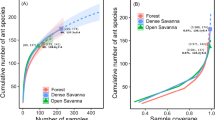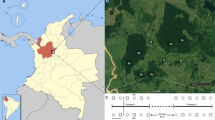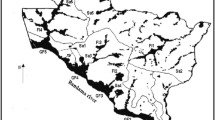Abstract.
The arboreal ant fauna was investigated in Budongo Forest, a seasonal rain forest in Uganda, using the insecticidal fogging technique. Ants were collected from 61 trees, between 7 and 33 m in height, belonging to four tree species. Trees were growing in adjacent plots of forests characterized by different use and structure: an old primary forest, a primary swamp forest along a small river, and a secondary forest where selective logging was carried out for 30 years. A total number of 37,065 ants, belonging to 161 species in 30 genera were collected. Considering the high number of species found only once, the completeness of the canopy ant fauna was relatively high and of relatively similar magnitude as samples from the Neotropics or the Oriental region. Up to 37 ant species on a single tree, with an average of 18.2 species per tree, were found. Forty-four ant species (28.1%) were found only once, less than ten individuals were found for each of 88 species (54.7%), but 64.0% of all individuals belonged to one of five species. Considering the high numerical dominance of a few ant species like a Pheidole sp., Tetramorium aculeatum (Mayr) and a Crematogaster sp., there is some evidence for an ant mosaic in the lower canopy of the Budongo Forest. Individual numbers of ants were strongly correlated with nests in the fogged tree, though the ants were not homogeneously distributed in the tree crowns. Diversity measures that strongly depend on individual numbers such as the Morisita-Horn index or rarefaction methods were calculated, but results were not concordant with those of incidence-based estimates such as jack-knife calculations. Differences in ant species richness and faunal composition between tree species were low, but more significant between forest types. The ant fauna in the secondary forest was less diverse with 12.6% fewer species compared to the primary forest sites. The average number of ant species per tree was significantly lower in the secondary forest (<20% of the species; F=8.03, df=59, P<0.01) than in the undisturbed forest types. Cataulacus, Leptothorax, Tetraponera, and Polyrhachis, which are typical canopy-dwelling ant genera, had a significantly higher diversity and frequency in the two primary forest types (F=4.17, df=53, P<0.05). Secondary forest trees are often younger, lacking dead branches and epiphytes which are important requisites for ant colonization on trees.
Similar content being viewed by others
Author information
Authors and Affiliations
Corresponding author
Additional information
Electronic Publication
Rights and permissions
About this article
Cite this article
Schulz, A., Wagner, T. Influence of forest type and tree species on canopy ants (Hymenoptera: Formicidae) in Budongo Forest, Uganda. Oecologia 133, 224–232 (2002). https://doi.org/10.1007/s00442-002-1010-9
Received:
Accepted:
Published:
Issue Date:
DOI: https://doi.org/10.1007/s00442-002-1010-9




